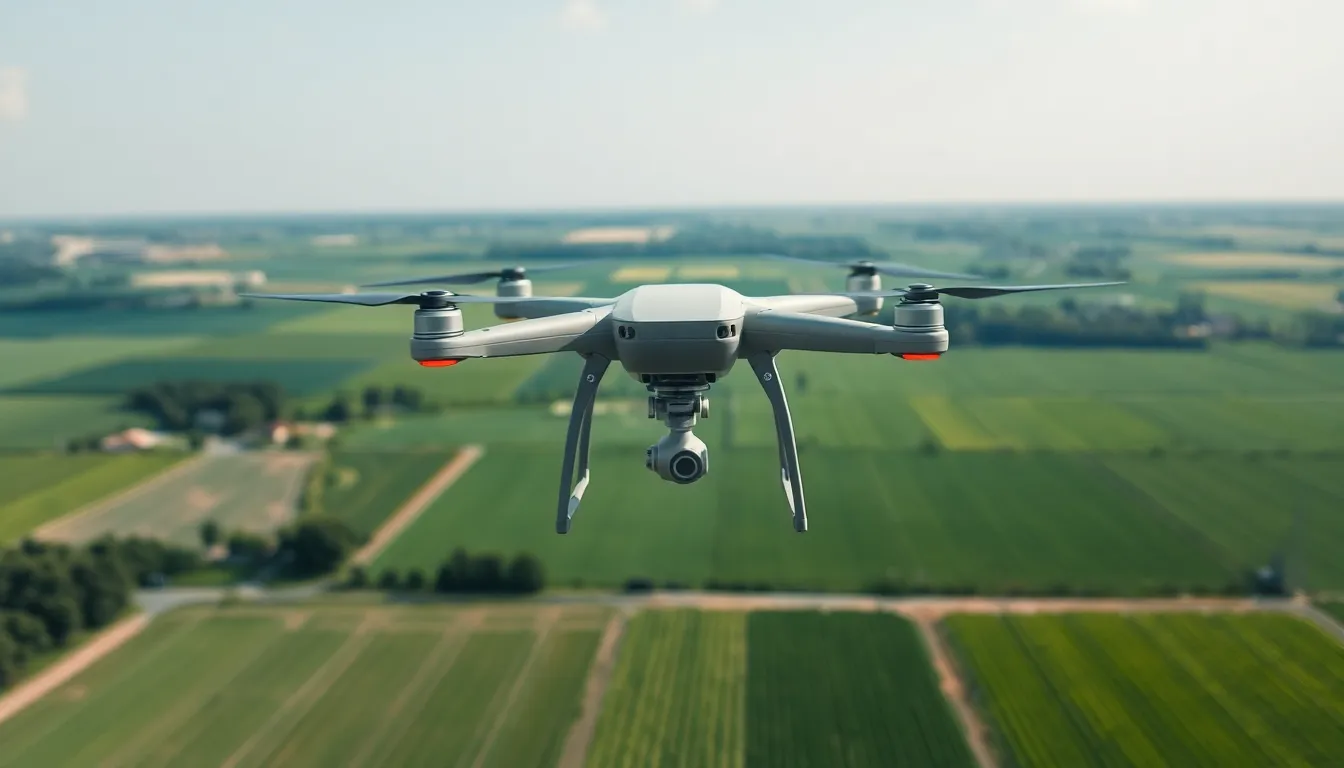Drones are no longer just the toys of tech enthusiasts or the eyes in the sky for filmmakers. With the rise of AI integration, these flying marvels are transforming industries faster than you can say “hoverboard.” Imagine a world where drones not only deliver your pizza but also analyze crop health, inspect infrastructure, and even help with search and rescue missions. Sounds like something out of a sci-fi movie, right?
Table of Contents
ToggleOverview of Drone AI Integration
Drone technology has significantly evolved with the integration of artificial intelligence. AI empowers drones to analyze data in real time, enhancing their operational capabilities. Industries use drones equipped with AI for various applications, including agriculture, where they monitor crop health and optimize yields.
Delivery services leverage AI-driven drones for efficient logistics. These drones navigate complex environments, ensuring timely delivery of goods. Search and rescue operations benefit from AI integration, enabling drones to quickly assess emergency situations and provide critical information.
Infrastructure inspection becomes easier through AI-enhanced drones. These devices detect signs of wear or damage, facilitating timely maintenance and reducing costs. In addition, environmental monitoring utilizes AI, allowing drones to collect data on air quality, wildlife populations, and more.
Autonomous flight is another key aspect of drone AI integration. Drones navigate predetermined routes without human intervention. Real-time decision-making capabilities depend on AI algorithms, enhancing safety and operational efficiency.
Data processing raises the potential of aerial mapping and 3D modeling. AI interprets aerial images, creating accurate topographical maps useful for construction and urban planning. As industries continue to adopt drone technology, the role of AI integration will expand, shaping a more efficient future across numerous sectors.
Key Technologies Behind Drone AI Integration

Drones leverage various technologies to achieve enhanced functionality through AI integration. Key technologies include machine learning algorithms and computer vision systems, both crucial in transforming drone capabilities.
Machine Learning Algorithms
Machine learning algorithms play an essential role in processing vast amounts of data. These algorithms improve drones’ performance by learning from previous flights and operational data. They enable predictive maintenance, which helps identify potential failures before they occur. With reinforcement learning, drones adapt their paths based on changing environments. In agriculture, machine learning algorithms analyze crop conditions and recommend actions for improved yields. Efficiency increases as drones become smarter with each operation, optimizing navigation and task execution.
Computer Vision Systems
Computer vision systems allow drones to interpret and understand visual data effectively. These systems utilize image processing techniques to enhance object detection and recognition. Drones equipped with computer vision can navigate complex terrains and avoid obstacles. By analyzing aerial images, they facilitate accurate mapping and data gathering. In infrastructure inspections, computer vision systems identify structural anomalies that might indicate deterioration. Their application in search and rescue operations supports real-time assessments of environments, ensuring swift decision-making. Enhanced by computer vision, drones have become invaluable tools across various industries, delivering precise insights.
Applications of Drone AI Integration
Drone AI integration enhances capabilities across several industries, transforming operations and improving efficiency.
Agriculture and Farming
AI-equipped drones revolutionize agriculture by enabling precise crop monitoring. These drones collect real-time data on soil conditions, moisture levels, and crop health. Farmers utilize this information to make informed decisions, thus optimizing yields. Automated systems analyze patterns in crop growth, suggesting irrigation and fertilization adjustments tailored to specific areas. Such advancements reduce resource waste and enhance sustainability in farming practices.
Disaster Management
AI-driven drones play a pivotal role in disaster management strategies. They quickly assess affected areas during emergencies, providing critical images and data to first responders. Equipped with advanced sensors, drones analyze structures, detect hazards, and identify safe routes for evacuation. Their integration into response teams helps streamline operations and improve situational awareness. Additionally, AI assists in predicting disaster outcomes by processing past event data, thus aiding in better preparedness efforts.
Infrastructure Inspection
Infrastructure inspection benefits greatly from drone AI integration. Drones equipped with computer vision can identify structural defects within bridges, buildings, and roads. By analyzing high-resolution images, these drones detect wear, corrosion, and other potential risks. Regular inspections performed by drones mitigate maintenance costs and enhance safety. AI further optimizes this process, allowing for predictive maintenance based on data collected over time, ensuring infrastructures remain in good condition.
Benefits of Drone AI Integration
AI integration significantly improves drone functionality. Enhanced data analysis allows for quicker decision-making across sectors. In agriculture, AI-equipped drones monitor crops efficiently, resulting in optimized yields. Efficient logistics benefit from drone delivery systems, which navigate complex environments to ensure timely goods distribution.
Safety is another major advantage. Autonomous flight capabilities enable drones to follow predetermined paths without direct human control. Real-time decision-making features enhance overall safety during operations. In search and rescue scenarios, drones quickly gather crucial information, which aids emergency responders.
Operational efficiency receives a substantial boost as well. AI aids in predictive maintenance, minimizing downtime and lowering costs in infrastructure inspections. These drones utilize machine learning algorithms to process extensive datasets, identifying wear and damage on structures effectively. Predictive maintenance integrates seamlessly with operational workflows, ensuring long-term durability.
Cost reduction plays an essential role in several applications. AI in agriculture helps farmers reduce input waste by providing precise soil condition data. Consequently, this resource optimization translates into significant financial savings. Inspections of infrastructure with AI also result in cost efficiencies, as potential issues can be detected early.
Environmental monitoring stands to gain from AI integration too. Drones collect critical data on air quality and wildlife protection, facilitating more informed ecological decisions. Organizations can respond promptly to environmental changes, promoting sustainability efforts.
Overall, the multifaceted benefits offered by drone AI integration pave the way for innovative applications, reshaping industries while enhancing performance and efficiency.
Challenges and Limitations
Drone AI integration faces several challenges and limitations that impact its full potential. One significant issue is regulatory constraints. Various government agencies impose strict regulations on drone operations, particularly regarding airspace use. These regulations often limit operational scope and increase compliance costs for businesses.
Technical issues also arise with the integration of AI in drones. Sensor malfunctions can lead to inaccuracies in data processing and decision-making. Limited battery life further restricts operational ranges, affecting performance in extensive operations. Connectivity problems join the list, as drones depend on reliable communication channels for effective function.
Security concerns pose another challenge. Cybersecurity threats can compromise the data drones collect and transmit, potentially leading to breaches of sensitive information. Trust becomes critical since stakeholders must rely on the security of autonomous systems for mission success.
Cost implications shouldn’t be overlooked. Implementing advanced AI systems in drones involves high initial investment. Maintenance and updates can further strain budgets, particularly for smaller enterprises.
Self-learning capabilities, while promising, also introduce unpredictability. Drones need extensive training data to develop accurate predictive models, highlighting the importance of quality data feeds. Without this, AI’s effectiveness may diminish, resulting in unexpected outcomes.
Finally, public perception plays a role in limiting drone acceptance. Concerns about privacy and safety often arise, leading to resistance from communities. Addressing these social challenges requires transparent communication from developers and regulators.
Navigating these challenges is essential for advancing drone AI integration and unlocking its full potential across various industries.
The integration of AI in drone technology is revolutionizing how industries operate. With enhanced capabilities in real-time data analysis and autonomous navigation, drones are becoming indispensable tools in agriculture, logistics, and emergency response. This transformation not only boosts efficiency but also opens doors to innovative applications that were once the realm of science fiction.
Despite the challenges that come with this technological shift, the benefits significantly outweigh the obstacles. As industries adapt and regulations evolve, the potential for AI-driven drones continues to expand. Embracing this integration will be crucial for businesses looking to stay competitive in an increasingly tech-driven world. The future of drone AI integration promises to reshape industries and improve operational outcomes across the board.









